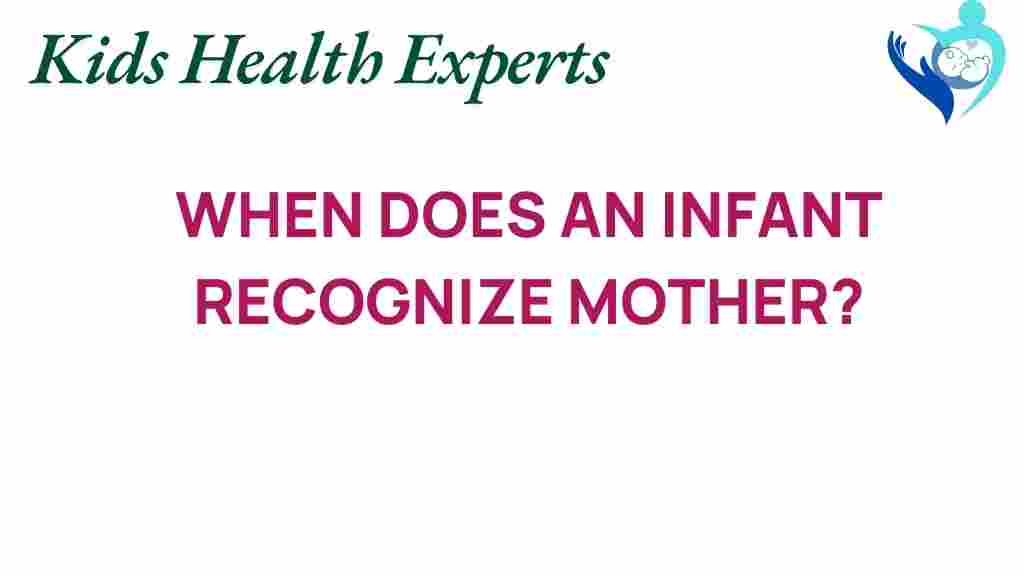Unraveling the Mystery: When Do Infants Truly Recognize Their Mothers? – Understanding Infant Recognition
As new parents embark on the journey of parenthood, one of the most heartwarming milestones is witnessing their infant’s recognition of their mother. This emotional connection forms a vital part of early development, shaping the infant’s understanding of relationships and security. But when do infants truly recognize their mothers? In this article, we will explore the intricacies of infant recognition, the maternal bond, and the developmental milestones that contribute to this profound connection.
The Early Stages of Newborn Awareness
Newborns enter the world with limited awareness, but they are far from oblivious. From the moment they are born, infants exhibit signs of newborn awareness. Research shows that even in the early days, infants can identify their mother’s voice and scent. Here are some key points about their early recognition abilities:
- **Voice Recognition**: Studies indicate that infants can recognize their mother’s voice within the first few days after birth, which is crucial for establishing their first emotional connections.
- **Scent Recognition**: A mother’s unique scent is another powerful cue for her infant. Babies are drawn to their mother’s scent, often preferring it over others.
- **Visual Recognition**: While newborns are initially limited in their vision, they can see well enough to recognize their mother’s face at close range, typically around 8 to 12 inches away.
Understanding the Maternal Bond
The maternal bond is a complex interplay of emotional and psychological connections that develop between a mother and her child. Attachment theory, proposed by psychologist John Bowlby, emphasizes the importance of nurturing relationships during infancy. This theory can help us understand how and when infants recognize their mothers:
- **Attachment Formation**: Attachment theory suggests that a secure attachment forms when a caregiver is consistently responsive to an infant’s needs, fostering a sense of safety and belonging.
- **Emotional Connection**: The emotional connection between a mother and her infant is vital for healthy psychological development. Infants who feel securely attached are more likely to explore their environment and develop confidence.
- **Impact of Maternal Instinct**: A mother’s instinct to bond with her newborn is often instinctual and can be observed through behaviors like holding, feeding, and soothing the infant.
Key Developmental Milestones in Infant Recognition
As infants grow, their ability to recognize their mothers becomes more pronounced. Here are some important developmental milestones related to infant recognition:
- **2 to 3 Months**: By this age, infants begin to respond to their mother’s face with smiles and coos, indicating that they are recognizing her visually and emotionally.
- **4 to 6 Months**: Infants can differentiate between familiar and unfamiliar faces. They may show signs of distress or shyness when meeting new people, signaling their attachment to their mother.
- **6 to 9 Months**: Around this time, babies may display separation anxiety, a sign that they have formed a strong bond with their primary caregiver, often their mother.
- **9 to 12 Months**: By the end of the first year, infants typically exhibit clear signs of attachment, such as reaching for their mother or crawling towards her when upset.
Factors Influencing Infant Recognition
Several factors can influence how and when infants recognize their mothers:
- **Time Spent Together**: The more time a mother spends with her infant, the stronger their bond and recognition become.
- **Responsive Parenting**: Mothers who are attentive and responsive to their infant’s needs foster a sense of security, enhancing emotional connections.
- **Environmental Factors**: External factors such as stress, maternal health, and family dynamics can also impact the development of the maternal bond.
Step-by-Step Process: Nurturing Infant Recognition
To nurture infant recognition and strengthen the maternal bond, consider the following steps:
- Engage in Skin-to-Skin Contact: This practice promotes bonding and helps the infant recognize their mother through touch and warmth.
- Utilize Voice and Scent: Talk to your baby regularly and let them become familiar with your voice. Skin-to-skin contact can also help them recognize your scent.
- Maintain Eye Contact: Look into your baby’s eyes during feeding or playtime to enhance visual recognition and emotional connection.
- Be Responsive: Respond promptly to your baby’s cries and cues. This responsiveness builds trust and reinforces their attachment.
- Establish Routines: Consistent routines can help infants feel secure and reinforce their recognition of you as their primary caregiver.
Troubleshooting Tips: Addressing Recognition Delays
In some cases, parents may notice delays in their infant’s recognition of them. Here are some troubleshooting tips:
- Consult a Pediatrician: If you have concerns about your infant’s development, consult your pediatrician for guidance and reassurance.
- Evaluate Your Bonding Time: Reflect on the time spent with your infant. Increasing one-on-one time can help enhance recognition.
- Engage in Play: Playtime is an excellent opportunity for bonding. Try using toys that stimulate visual and auditory senses.
- Monitor Environmental Stressors: High-stress environments can hinder bonding. Strive to create a calm and nurturing atmosphere for your infant.
Conclusion
Understanding when and how infants recognize their mothers is a fascinating journey into the world of infant recognition and the maternal bond. The emotional connection established during the early months is crucial for healthy psychological development and lays the groundwork for future relationships. By being aware of the developmental milestones and nurturing the bond through responsive parenting, mothers can foster a strong attachment with their infants. If you’re interested in learning more about the science of attachment and early development, consider visiting this resource for additional insights.
In conclusion, every moment spent nurturing this bond is invaluable, not just for the infant but also for the mother, as it strengthens the maternal instinct and enriches the parenting experience.
This article is in the category Growth and created by KidsHealthExperts Team
